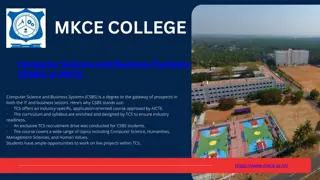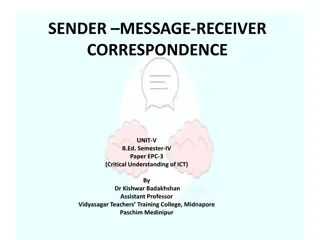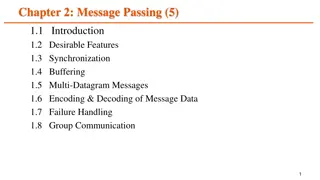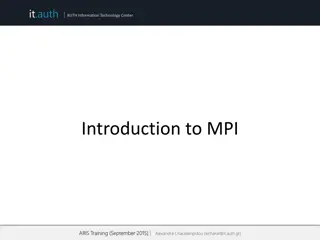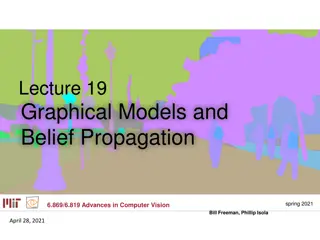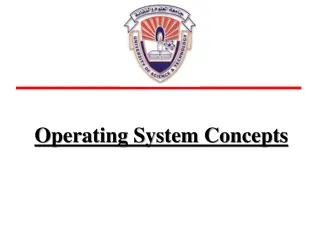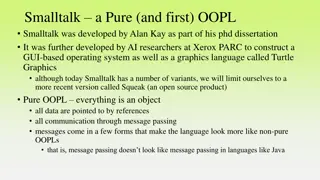Understanding Message Passing Models in Computer Science
Message passing models in computer science involve concepts like producer-consumer problems, semaphores, and buffer management. This content explores various scenarios such as void producers and consumers, as well as the use of multiple semaphores. The functions of message passing are detailed, highlighting how processes communicate through messages.
Download Presentation

Please find below an Image/Link to download the presentation.
The content on the website is provided AS IS for your information and personal use only. It may not be sold, licensed, or shared on other websites without obtaining consent from the author. Download presentation by click this link. If you encounter any issues during the download, it is possible that the publisher has removed the file from their server.
E N D
Presentation Transcript
PRODUCER-CONSUMER PROBLEM buffer producer consumer
Two semaphores empty (i.v. 1) full (i.v. O)
void producer(void) { while (TRUE) { <generate message to put in the buffer >; P (empty); <put new message in the buffer>; V (full); } }
void consumer(void) { while (TRUE) { P (full); <takeonemessagefromthebuffer>; V(empty); <consume the message>; } }
buffer producer consumer
Three semaphores empty (i.v. N) full (i.v. O) mutex (i.v. 1)
void producer (void) { while (TRUE) {< generate one message to be put into the buffer >; P (empty); P (mutex); <put the new message in the buffer>; V (mutex); V(full);} }
void consumer(void) {while (TRUE) {P (full); P(mutex); <take one message from the buffer>; V(mutex); V(empty); <consume the message>;} }
The functions of message passing are normally provided in the form of a couple of primitives: send (destination, message) receive (source,message)
One process sends information in the form of a message to another process designated by a destination
A process receives information by executing the receive primitive, to obtain the source of the sending process and the message
Design issues of message systems: Addressing Synchronization
Addressing Direct addressing Thesendprimitiveincludes a specific identifier for the destination process send (P2, message)
The receive can be handled in one of the two ways: The process explicitly design a sending process: receive (P1, message)
If it is impossible to specify in advance the source process
implicit addressing: the source parameter specifies a value yelded when the receive operation has been performed to indicate the sender process.
Indirect addressing Messages are not directly sent from senders to receivers
Messages are sent to intermedia shared data structures (mailbox) that can temporaly hold messages
The relationship between senders and receivers can be: one-to-one many-to-one many-to-many
A one-to-one relationship allowsprivatecommunication to be set up betweeen a couple of processes.
A many-to-one relationship is useful for client-server interaction. The mailbox is often referred to as a port
client/server model P1 server R port Pn client
A one-to-many relationship allows for one sender and multiple receivers.
It is useful for applications where messages are to be broadcasted to groups of reveiver processes.
Message message type origin e destination ID header source ID message length control information body message contents
SYNCHRONIZATION The communication of a message between two processes implies some level of synchronization
SYNCHRONIZATION The receiver cannot receive a message until it has been sent by another process
In addition, we need to specify what happens to a process after a send or receice primitive.
Message passing may be either blocking or nonblocking (synchronous or asynchronous)
Blocking send: the sending process is blocked until the message is received either by the receiving process or by the mailbox.
Nonblocking send: the sending process sends the message and immediately resumes operation.
Blocking receive: the receiver blocks until a message is available.
Nonblocking receive: if there is no waiting message, the process continues executing, abandoning the attempt to receive.
Rendez vous betveen the sender and the receiver: both send and receive are blocked by the operation
Extended rendezvous: the sender is blocked until the receiver completed the implied action.
KERNEL OF A PROCESS SYSTEM
A small set of data structures and functions that provide the core support to any concurrent program.
The role of a kernel is to provide a virtual processor to each process
Kernel data structures PCBs process_in_execution ready-process-queues semaphores and blocked- process-queues
Kernel functions Context switch management: save and restore the PCBs of the processes.
Kernel functions Decision of the ready process to which assign the CPU.
Interrupt handling Operations on processes (system calls)
The kernel starts executing when an interrupt occurs External interrupts from peripheral devices
Internal interrupts or traps triggered by the executing process
Example A stack is associated to any process
Example Double set of general registers R1, R2, , Rn and R 1, R 2, , R n and two registers SP and SP (user and kernel)
P PCB P stack kernel stack SP R1 1 SP Rn n R1 Process-in- execution Rn g PC value of the process that g PC value of the process that executed the executed the SVC SVC d PS value of the process that d PS value of the process that executed the executed the SVC SVC interrupt handler address interrupt handler address z kernel PSW z kernel PSW PC PS
P PCB P PCB kernel stack 1 1 n n P stack P stack SP R1 SP 1 R1 Rn n Rn PC Process- in -execution iret address Kernel PSW PS






